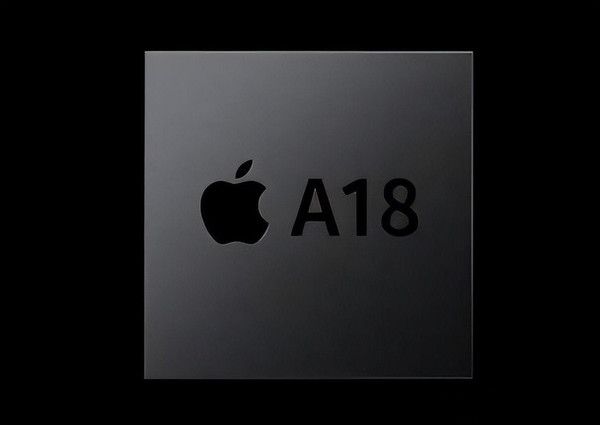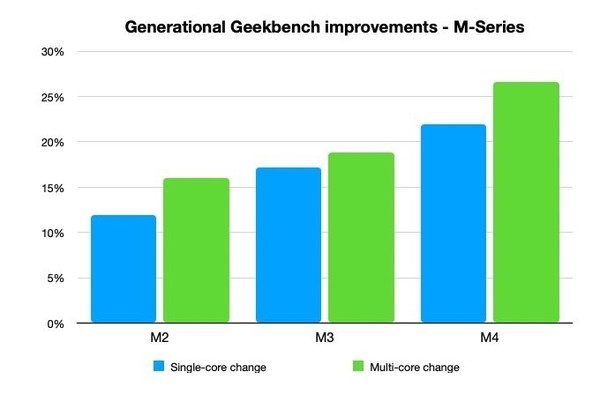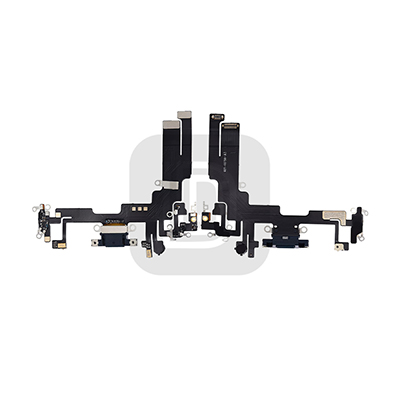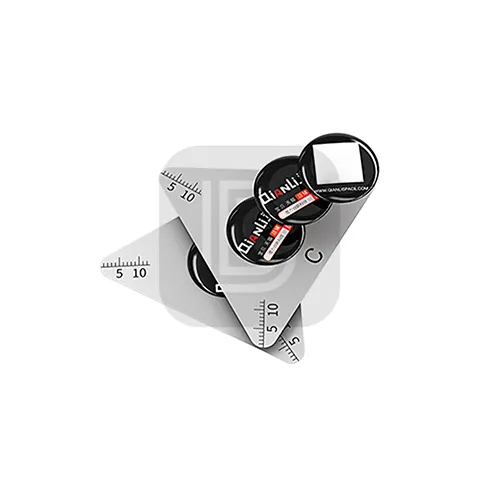Science and Technology Preface
Every September, Apple brings a new generation of iPhones, and this year, Apple will equip the iPhone 16 Pro with the latest A18 chip. Every year, Apple’s updates to the A-series chips attract a lot of attention, and relevant news is covered in various volumes before release. Through Apple’s newly launched M4 chip, we may be able to see the shadow of the A18, and even infer the performance of the possible M3 Ultra chip.

What is M4 chip
After years of iterations of A-series chips, iPhone has always been at the forefront in terms of processing power and performance. On the Mac side, Apple’s M chip has now entered its fourth generation and is impacting the PC industry in its own unique way. In fact, because the M4 chip was released before the M3 Ultra chip appeared, it also affected Apple itself to some extent.
Apple’s mobile chip series is iterating at a rate of one generation per year, and Mac chips are also following suit. With the release of the new iPad, more people are focusing on Apple’s next-generation A series and M series chips. Analysis of past chip releases and the new M4 chip in iPad Pro may give us some clues about Apple’s upcoming products.
Of the two chip series focused on above, the M series may be more difficult to predict. This is because Apple releases more chips in each generation of the M series. In contrast, its A series contemporaries have much fewer products, with only small changes in the number of cores per chip. For comparison, Apple has released a total of 12 chips in the four generations of M series products.
Among the currently announced M series chips, M1 and M2 chips are available in standard version, Pro version, Max version and Ultra version. The M3 has standard, Pro and Max versions, and the Ultra version will be launched soon. However, only the standard version of the M4 has been released. It’s almost become a given that over time, Apple is likely to make improvements at every level of each chip generation, showing greater progress.
Given that Apple’s technological advancements are expected between generations of chips, this makes speculating on new chips relatively easy. This includes the so far unannounced M3 Ultra and new other M4 series chips.

Pro and Max chip analysis
First of all, the base version of each generation of the M series is usually an eight-core design. Divided into 4 performance cores and 4 energy efficiency cores. However, this trend has changed in the M4, and Apple has used a nine-core or ten-core design. Both versions have six energy-efficiency cores, but there are either three or four performance cores.
Pro and Max chips generally have more cores available, with the M3 up to 16 cores. In that chip, it is divided into 12 performance cores and four energy efficiency cores. The Ultra chip is actually a combination of two Max chips. Compared with the Max chip of the same generation, its performance has doubled in many parameters.
In addition, the number of GPU cores has gradually increased over time, from 7 or 8 on the M1 to 10 on the M4. The Neural Engine (NPU) remains 16 cores throughout the life of Apple’s M chips and 32 cores on Ultra chips. However, performance improved between generations due to the increased number of transistors per core.
For M1, the number of NPU operations per second is 11 trillion times, M2 increases to 15.8 trillion times, and M3 is 18 trillion times. In the M4, things change dramatically, with Apple claiming it’s capable of 38 teraflops. This is more than twice the performance of the M3 NPU.
In addition to the number of cores, another factor that improves performance is memory bandwidth. The M1’s memory bandwidth is only 68.25GB/s, rising to 200GB/s for the M1 Pro, 400GB/s for the M1 Max, and 800GB/s for the M1 Ultra. Memory bandwidth has changed considerably over a period of time. For example, the M3 Pro has a bandwidth of 150GB/s, while the M4 has a bandwidth of 120GB/s.
Compared with complex variable analysis, there is actually a simpler way to judge performance, and that is to view actual performance test data. The figure below shows the Geekbench single-core and multi-core results of the released M-series chips. Although the results of this benchmark may not be perfect. For example, the benchmark differences between the Pro and Max chips aren’t huge. However, in actual use, there is a huge gap between the two in some scenarios, but this is not a universal situation.

In this set of data, the one with more abnormal performance is M4, because it is the only chip tested based on iPad Pro. Given the level of performance it has, it shouldn’t have much of an impact on the results, but it doesn’t get better cooling like its Mac counterpart. However, the results show that the later and higher-level chips have generally better performance. That’s not surprising, but it’s not entirely helpful either.
To think about it from another angle, we should look at the basic chips of each generation: M1, M2, M3 and M4. Comparing just these four chips, you can clearly see the improvement between generations, and the improvement becomes larger as you go later. From M1 to M2, its single-core performance increased by 12% and multi-core performance increased by 16%. From M3 to M4, they increased by 22% and 27% respectively.

However, due to some major differences between Pro, Max and Ultra chips, they are not suitable for such comparison. For example, the M3 Pro’s multi-core score is only 7% higher than the M2 Pro’s, in part because Apple changed the ratio of performance cores to efficiency cores in that version. As for the M3 Ultra, while the data may not be completely accurate, we can use these data and the specifications of other released Apple chips to make a reasonable guess at its hardware capabilities.

The easiest one to guess is the M3 Ultra, which is likely to be unveiled at WWDC. If Apple keeps its usual course, the M3 Ultra will perform twice as well as the M3 Max in every aspect, but that’s just a reasonable guess since there’s no obvious “hard connection” in the M3 like there is in the M1 and M2. In theory, the M3 Ultra may be equipped with a 28- or 32-core CPU, including 20 or 24 performance cores and eight energy-efficiency cores. It will also have a 32-core neural engine that can perform 36 trillion calculations per second. , and 800GB/s memory bandwidth.
As for the M4 Pro, Max, and Ultra, we can follow the various variants of the M3 and slightly increase many of the specifications to come up with a rough number. For example, the M4 Pro may have 11 or 12 CPU cores like the M3 Pro. But since Apple has increased the core count of the M4, the Pro version may increase to 13 or even 14 cores. The M4 Max may be equivalent to the M3 Max’s 14 or 16 core count. Likewise, the M4 Ultra can double the power of the M4 Max.
In terms of GPU cores, Apple may increase the number moderately. For example, the Pro may have 16 to 20 cores, and the Max may have 40 to 50 cores. Apple likes to keep the Neural Engine consistent across generations of products, so the M4’s 16-core 38TOPS will be extended to the Pro and Max. The Ultra version will reach 76TOPS after doubling.
If the M4 Pro and Max have the same performance improvements as the M4, the new numbers might be surprising. Taking the M3 Max as an example, based on a 22% improvement, its single-core performance may reach around 3800 in Geekbench. If the 27% improvement is maintained, the multi-core performance may exceed 26,000. But this is still just speculation, and the specific situation will not be revealed until the chip is released.
Like the M series, the A series chips have undergone a long period of updates over the years. Since Apple’s design team is responsible for both chip lines, it’s easy to expect quite a few similarities between the two.
In fact, Apple’s M-series was originally developed based on its experience building A-series chips. Although there are many similarities between the two, there are also many differences. Because the A series is primarily designed for iPhones and iPads, not Macs. Since there is no active cooling on Apple’s mobile devices, Apple must allow A-series chips to run at lower temperatures. In addition, most iPhone users do not use their phones to process high-load content. Starting with the A13, Apple has used a six-core design that includes two performance cores and four energy-efficiency cores on its A-series chips. That’s two performance cores less than most M-series cores.

For the same reason, the A-series GPUs also suffer and therefore use fewer cores. The A13 and A14 have four GPU cores, the A15 and A16 have five, and the A17 Pro has six. If you start with A14 and look up together with M1, you can find that except for A17 and M4, which have six cores and ten cores respectively, the A series has half the number of cores of the M series.
However, since Apple typically offers two different GPU core counts on a single chip, and the M4 has only offered one so far, the first Macs to use the chip will likely feature the second option. Following the trend, it should be a 12-core version. The NPU in the A series has 16 cores, consistent with the M series. However, its performance seems to be similar to the M chip. The A14’s Neural Engine can perform 11 trillion operations per second like the M1, and the A15’s 15.8 trillion operations is the same as the M2. The A16 is slightly different at 17 teraflops, while the M3 is 18 teraflops. Like the M4, the A17 Pro’s NPU performance is boosted to 38 trillion operations per second.
In terms of manufacturing process, the A series and M series are also related to a certain extent. Starting from 5nm of A14 and A15, A16 has been upgraded to 4nm, and A17 Pro has reached 3nm. This is again somewhat on par with the M series, except the M3 skips 4nm straight to 3nm.
In terms of performance, the A series has witnessed an incredible improvement in performance. In Geekbench, iPhone performance starts with the A13’s single-core 1722 and multi-core scores of 3848, and the A14’s single-core performance breaks 2000 and multi-core almost reaches 5000. On the A17 Pro, its single-core score is 2899 and multi-core score is 7202.

From A13 to A17 Pro, the single-core performance of A-series chips has increased by 68% in four years, but multi-core performance has increased by 87% in the same period. From an iteration perspective, the single-core performance of A14 is 22% higher than that of A13, and the multi-core version is 26% higher. In subsequent years, the growth rate decreased, ranging from 10% to 16% per year. On the A17 Pro, the single-core and multi-core upgrades are 13% and 10% respectively.
Judging from the specifications and data alone, we can have a good guess about what the A18 will look like. First, Apple seems inclined to maintain its six-core layout over time, so the two performance cores and four energy efficiency cores may still be retained. Due to heat dissipation limitations, Apple is unlikely to change the past rules in GPU core count, so there is a strong possibility that the A18 will maintain six cores like the A17 Pro. In terms of performance, according to previous rules, the performance improvement of A18 on Geekbench is at least 10% compared to A17 Pro. This means that the single-core test score is likely to be around 3200, and the multi-core test will be around 7900.

The real improvement of A18 should be in AI, which may also be the main upgrade point of iPhone 16 Pro this time. There are rumors that Apple will strengthen the AI capabilities of its chips to lay the foundation for the iPhone’s AI capabilities. However, Apple has made some changes on the A17, doubling the NPU computing power of the A16 to 38 trillion per second.
If Apple wants to make efforts in AI, it should make a fuss about NPU, which should mean that Apple may upgrade to more powerful NPU cores, or increase the number of original cores, or combine the two. No matter what Apple does in the end, I believe users who want to buy a Mac in the future will pay close attention. Because what kind of A18 chip Apple comes up with will determine whether the M5 will develop in the same direction in the future.

















